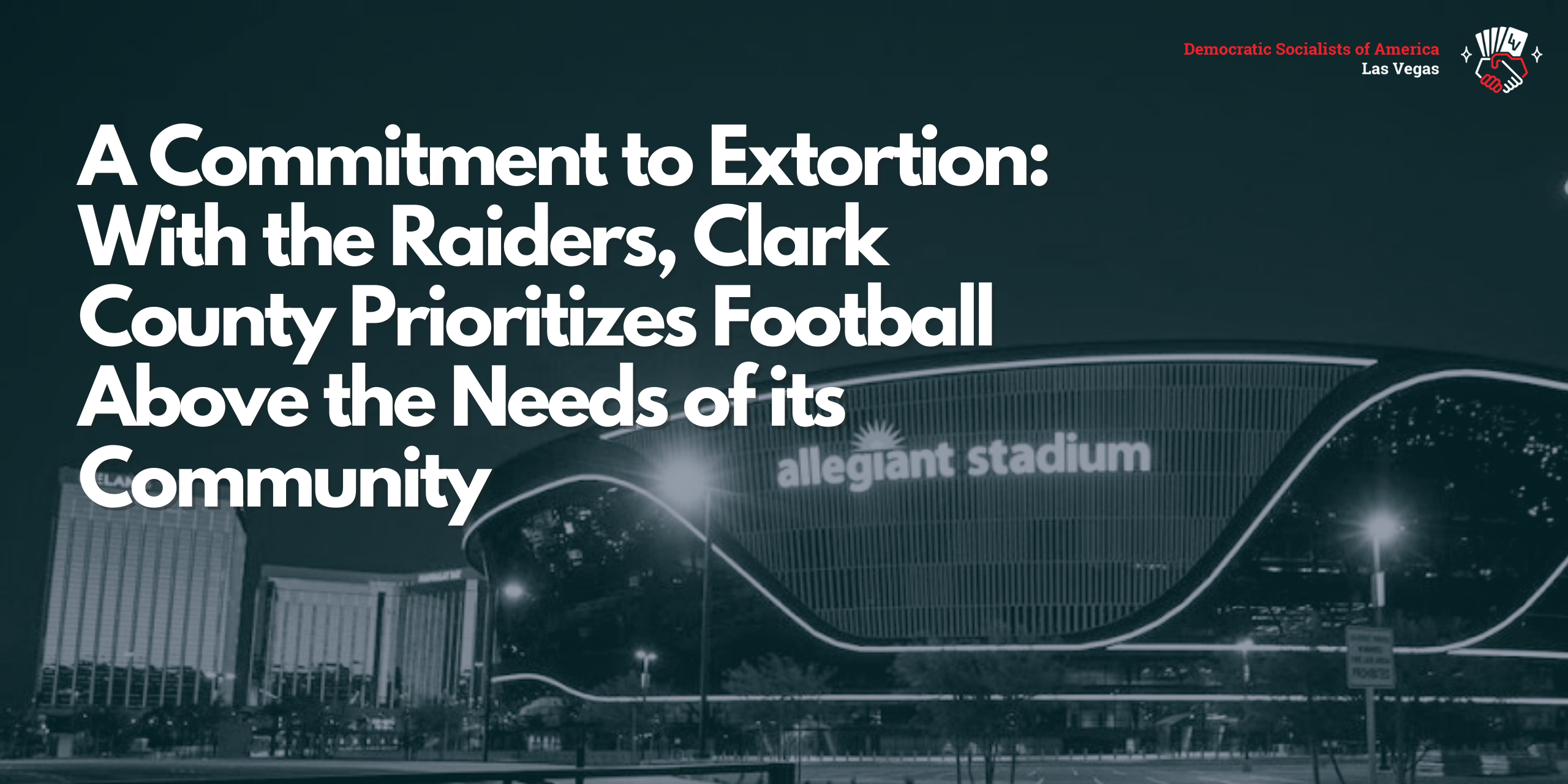A Commitment to Extortion: With the Raiders, Clark County Prioritizes Football Above the Needs of its Community

Working-class Americans are suffering under the weight of the COVID-19 pandemic, the related economic downturn and a substantial lack of action from elected officials.
It’s been particularly tough on Las Vegas, which has seen the highest rates of unemployment of any major metropolitan area in the country and a casino-dominated economy relying heavily on tourism dollars only trickling in at the moment. To plug holes in the state’s budget, Nevada is using massive amounts of “rainy day funds” and Governor Steve Sisolak is prepping state agencies for austerity measures.
Sisolak could have access to approximately $11.55 million more this month in reserve account public funds. Yet, due to a deal he helped arrange as Clark County Commission Chairman, it belongs to the Las Vegas Raiders — in the form of paying off bond debt for their stadium.
In what was the largest direct public subsidy for a sporting venue in history — at $750 million — the Raiders’ stadium serves as a lasting, monumental reminder of disastrous public-private partnerships between multi-billion-dollar entities and municipal governments.
Initially, elected officials masked the inevitability Clark County tax payers would ultimately foot the bulk of the bill for this stadium. They pitched the haphazard narrative that the county’s debt obligation could be paid out entirely by raising Clark County strip hotel room taxes by 0.88% (non-strip properties by 0.5%) during the 30-year life of the stadium lease. But this funding mechanism fell apart in just three years. After raising $153.3 million since March 2017, room tax revenues fell by 71.5% over the course of a year. In July, officials projected a $13.5 million budget shortfall.
The county pledged to cover its funding promises for the stadium by selling “general obligation” bonds. Such bonds are a pledge by the county to pay back bondholders by raising taxes. This gives the county the authority to shift the debt obligation onto tax-paying residents if necessary. They deemed it necessary. As a result, the county pulled from a reserve fund of taxpayer dollars to repay its stadium debt.
In theory, general obligation bonds are supposed to be issued to help the citizens of Clark County — not to host a mediocre football team in front of zero fans. The county will continue to raid taxpayer reserves at the behest of their “obligation” to bondholders despite politicians downplaying the effects of the pandemic on stadium obligations initially. They remained stoically committed to the foolish notion that public funds should be committed to a football stadium, which only hosts about a dozen events per year.
Apparently, to our elected officials, it is more important for the county to pay back stadium debt than to meet the needs of its citizens suffering through an economic and public-health crisis. These reserve funds could be used for additional COVID relief, such as paying PUA claimants what they’re owed or providing much-needed rental assistance to forestall an unprecedented eviction crisis. In fact, even before the pandemic, it was absurd to divert resources that could be allocated to help the community. Imagine a $750 million investment in affordable housing, rather than the city of Las Vegas wasting resources to effectively criminalize homelessness and coordinating with neighboring municipalities to destroy citizen-built initiatives that combat the issue.
Or what about funds to our utterly abandoned public education system? In 2009, voters submitted the IP1 room tax initiative to the state legislature with the intention of supporting Nevada public education, raising funds via a mechanism similar to one the county created to pay off the stadium debts. In 2017, this generated $267 million derived from a three-percent room tax rate. However, the revenue from the room tax is deposited in the State General Fund and not specifically earmarked for K-12 education by the legislature, thus supplanting over $1.6 billion since 2011, according to Fund Our Future Nevada. In other words, money didn’t go to education as voters intended.
The stadium financing agreement made it clear even more funds could be made available for public use by raising the tax mere tenths of a percentage point, assuming the state legislature agrees to distribute those general funds for public use. Yet, the obligation to the stadium debt took precedence to public education when the Clark County School District approved a budget with a $38 million drop in revenue.
Of course, the horrors of hijacking public funds for NFL stadiums is hardly unique to Las Vegas, Clark County, or Nevada. For example, in Ohio, Hamilton County sold a public hospital and postponed infrastructure development while it incurred debt from the Cincinnati Bengals’ stadium.
The impact isn’t just reflected in budgetary constraints. Stadium construction and sporting events can lead to massive displacement and police violence, as Black and Latinx Los Angeles citizens disproportionately experienced in the wake of the 1984 Olympics. Given the new stadium and the allure of hosting events in Las Vegas, it’s not difficult to imagine the city hosting events on a similar scale.
The county funded the stadium, in part, because of its ability to draw the NFL Draft, a Super Bowl, college football bowl games and NCAA basketball tournament events, in addition to the Raiders. Those sporting spectacles generate billions of dollars and the working class citizens of Clark County won’t benefit at all.
Economists Robert Baade and Victor Matheson observed no positive correlation between subsidizing stadiums and job creation, despite politicians commonly citing a stadium’s ability to reduce unemployment. In fact, economist Dennis Coates studied the impact subsidized sports venues had on the growth rate of per capita personal income and determined sports franchises had a negative impact on the personal income of their communities.
In a 2010 study, urban planning professor Judith Grant-Long found taxpayer-financed stadiums and arenas cost $10 billion more than cities and states originally budgeted. Additionally, she found the following: “the costs of land, infrastructure, operations and lost property taxes add 25 percent to the taxpayer bill for the 121 sports facilities in use during 2010, increasing the average public cost by $89 million to $259 million.”
Grant-Long’s 2012 book “Public-Private Partnerships for Major League Sports Facilities” dives into greater detail, revealing between 2000-2010, U.S. municipalities spent $12 billion in public funds on 51 new professional sports facilities. Since 1990, the stadium and arena replacement rate is more than 90% — in that timeframe, the nomadic Raiders football team has played in three different cities: Los Angeles, Oakland and Las Vegas.
At this point it’s culturally ingrained in the Raiders organization to squeeze every cent out of their host city, a commitment to extortion — “Just Grift, Baby!” before bolting or threatening to leave. They bounced from their original home of Oakland and moved to Los Angeles in 1982 after owner Al Davis tried to leverage Alameda County to install additional luxury boxes in his stadium. The team moved back to Oakland in 1995 when Al Davis walked away from a Los Angeles stadium deal he found unfavorable.
Davis’s son, Mark, assumed control of the team when Al died, and just like his dad, he tried to strong-arm Alameda County into paying for a new stadium. That effort failed, so his contingency plan involved flirting with Las Vegas, thanks to Sheldon Adelson, and Los Angeles again.
The racket hasn’t quit since they arrived in Nevada. On top of the stadium debt heaped upon Clark County, the Raiders thievery morphed into an outright capitalist land grab — by selling their Henderson headquarters for $191 million in a lease-back deal with the city, the Raiders turned a profit of $185 million, more than 30 times what they originally paid for the land. That’s $185 million of public funds simply gone, to do nothing but line the pockets of the rich.
In 2019, the Raiders agreed to the league’s most valuable stadium naming rights deal, allowing Allegiant to slap its name on the desert roomba. Despite playing in a publicly subsidized venue, the county allowed the team, alone, to benefit from this revenue stream along with all concession and parking revenue generated from team events. While they continue to raid county coffers, we still know few details about the $650 million loan provided by Bank of America to complete the stadium’s near $2 billion construction cost.
Given their exploitation of state residents and recent on-field history, it might be too much to expect the Raiders to elicit much civic pride. So, if the past is any indication, they’ll spend the next 29 years eroding the remaining local fan support before moving back to Oakland.

